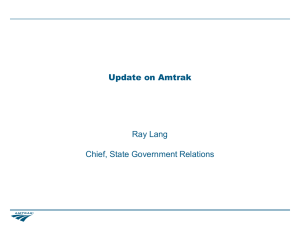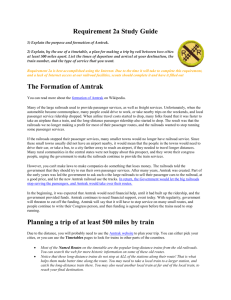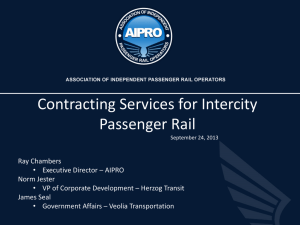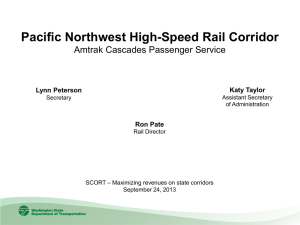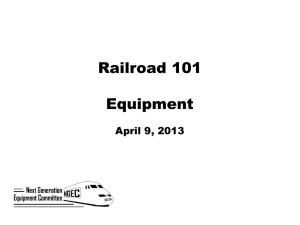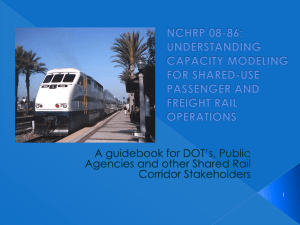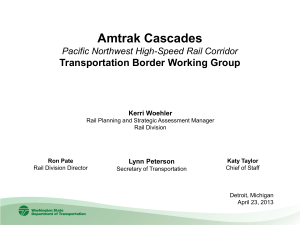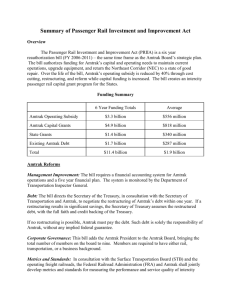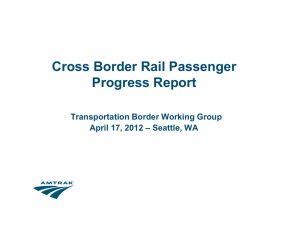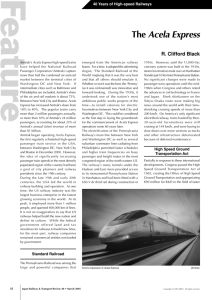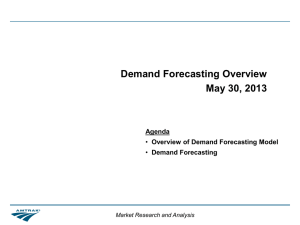Capital Charge
advertisement
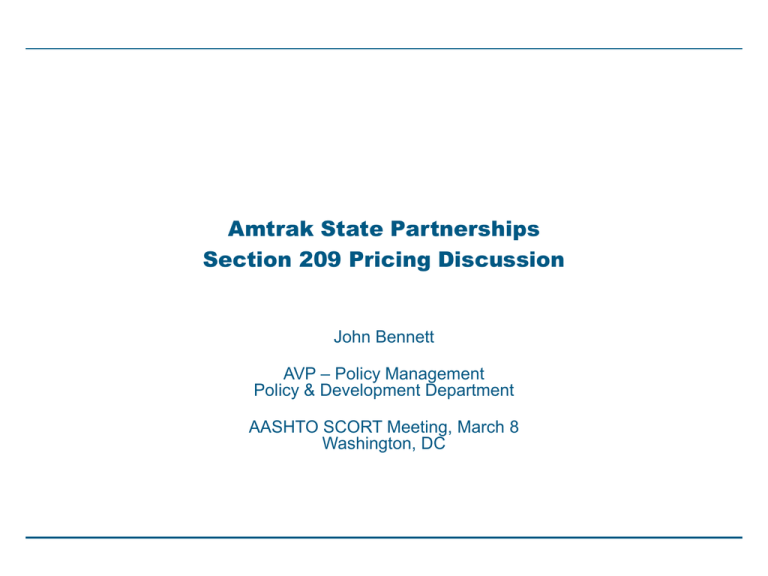
Amtrak State Partnerships Section 209 Pricing Discussion John Bennett AVP – Policy Management Policy & Development Department AASHTO SCORT Meeting, March 8 Washington, DC Today’s Discussion • Framing the Challenge • Actions Completed • Next Steps for Section 209 Development • Opportunities, Challenges, Key Questions 1 Amtrak Network Today Long Distance Routes: National network, greater than 750 miles Corridor Routes: Less than 750 miles Freight railroads: No passenger service 2 Statutory Evolution of State Supported Services 1975 • 1970 Rail Passenger Service Act: • Basic System – Amtrak required to operate designated routes • 403(b) – states can request additional service if they cover portion of costs 1985 • 1974-86: State share of costs specified under 403(b) amended by Congress 6 times; modest expansion of state service • 1986 provision: States required to pay portion of “shortterm avoidable loss” (45% in Yr 1, 65% in Yr 2), plus 50% of associated capital costs; significant expansion beginning in early 1990s 1995 • 1997 Amtrak Reform Act: Repeals 403(b), eliminating statutory requirements re: statesupported trains; also repeals requirement for Basic System trains • 1995-2001: Amtrak seeks higher state payments; but approach varies widely across 3 new “SBUs” 2005 • 2002-2007: Cost terms for all statesupported trains (formerly “403(b)”) standardized – states pay full “direct and shared operating costs not covered by revenues” Meanwhile system corridor trains continue to operate without state financial support creating an equity issue 3 PRIIA Initiatives and Requirements Sec. 207 - Metrics and Standards Sec. 210 - Long Distance Routes Sec. 209 - State-supported routes: Amtrak, states, and FRA must develop and implement a single nationwide standardized methodology for establishing and allocating operating and capital costs among the states and Amtrak Sec. 212 – NEC Infrastructure & Operations Improvements Sec. 213 – Passenger Train Performance Sec. 301 - Capital Assistance Sec. 302 - Congestion Grants Sec. 303 - State Rail Plans Sec.305 - Next Generation Corridor Equipment Pool Sec. 307 - Federal Rail Policy Sec. 501 - High Speed Rail Grants 4 Section 209 Overview: Clarifying the State/Federal Partnership • Federal government supports Amtrak service with operating support and capital infusion – Capital investments in equipment and infrastructure allow operating revenue to be used for operating support – Obviates need for ‘profit’ to be reserved for capital investment • State governments determine the amount and level of intercity corridor passenger rail desired: – State Rail Plans: “this is what we want” – Understanding of operating and capital cost implications (TBD through Sec 209 process): “these are the costs we have to cover” – Amtrak service agreements: “this is the deal” • States benefit from Amtrak’s Federal Government-supplied support: – Incremental cost access rights and dispatching priority to host railroads (the “public bargain” the private railroads made in return for federal relief from passenger service losses) – Rather than pay fully-allocated costs, states only pay direct costs, and some shared costs as determined through Sec 209 process—difference is federal support through Amtrak – Sec 209 and Sec 301 (Capital Assistance) allow states to use PRIIA capital funding for host railroad capital payments and Amtrak capital charge 5 State Supported Service Pricing - Section 209 Overview • Section 209 of PRIIA requires, within 2 years (October 16, 2010), that the Amtrak Board of Directors, in consultation with the DOT Secretary, the governors of each relevant State, and the DC Mayor, or entities representing those officials, develop and implement a single nationwide standardized methodology for establishing and allocating costs among the States and Amtrak. • Methodology applies to both the operating and capital costs • Applies to all current and future intercity passenger rail routes over a federally-designated HSR corridor and/or of less than 750 miles, excluding the NEC spine • Methodology must: – (1) Ensure equal treatment in the provision of like services of all States and groups of States (including the District of Columbia); and – (2) Allocate to each route the costs incurred only for the benefit of that route and a proportionate share, based upon factors that reasonably reflect relative use, of costs incurred for the common benefit of more than one route. 6 Section 209 Overview: Consequences of No Agreement • Methodology is to be defined and agreed upon within 2 years (October 16, 2010) and adopted and implemented within 5 years (October 16, 2013). • Failure to agree by all parties results in the development and imposition of a formula by the Surface Transportation Board (STB). • STB shall develop the methodology in accordance with section 24904(c) of Title 49, United States Code: – “…the costs Amtrak incurs only for the benefit of the carrier, plus a proportionate share of all other costs of providing transportation” (Emphasis added) • STB methodology would be implemented within one year after the Board's determination. 7 State Supported Train Pricing – Principles and Challenges • Basic principles for new operating cost methodology: – Consistency: “System” corridors must be converted to state support – Transparency: Understandable/straightforward – 100% of direct costs plus a proportionate amount of indirect costs – Service level based (as service changes associated costs change) – Management/assignment of risk • Challenges: – Linkage of future costs with future service plans – Linkage to the new Amtrak Performance Tracking (APT) system – Definition and cost recovery for capital costs—largely equipment and facilities – Cost forecasting and alignment with Amtrak’s operating budget – Type of service contract (pure cost-based, performance-based, negotiated contract structure) 8 Corridor Services – Impacted Routes NEC Spine: Excluded from Section 209 State Supported Routes: Require consistent agreements under Section 209 System Corridor Routes: Require new agreements, no state support in place Mixed State/System Routes: Requires conversion of system trains to state support 9 • Framing the Challenge • Actions Completed • Next Steps for Section 209 Development • Opportunities, Challenges, Key Questions 10 First Steps Toward a Standard Structure • Adopt Amtrak Performance Tracking (APT) system as the analytical framework for defining the future policy—new Federally supported model – Replaces RPS (Route Profitability System) – Jointly developed with US DOT Volpe National Transportation Systems Center – Incorporates analysis of “capital charge” • Begin transformation to a uniform structure: FY 2010 agreements based on an attempt to provide consistent treatment of major categories and risk—for those states with existing contracts (though not all states have concurred) – Payments based on: - Actual passenger revenues and host railroad payments - Agreed-upon fuel usage and cost methodology - Fixed values for remaining costs—defined as “service fees”—based on inflation-based increases (as adjusted, in some cases) to FY 2009 contract amounts – No change in current state-specific agreements on cost sharing— for now 11 Significant Advantages of APT – Technology and Structure RPS APT APT Advantage Mainframe based Client-server based •More transparent •Easier updates, reporting •Mainframe at end of life cycle Legacy RPS “Lines” “Families” of Res Centers and General Ledger Accounts • Res Centers and GL accounts widely used and understood at Amtrak Shared costs allocated only to Amtrak trains Shared costs allocated to Amtrak trains, commuter trains, freights, others • Improved accuracy and more equitable allocation 12 Amtrak Performance Tracking – Overview of Improved Process Cost Type Examples How Handled in APT Direct, trainspecific data • Train & engine labor • OBS labor • Host RR payments •Assigned directly to a train Direct, no trainspecific data • Fuel & power • Turnaround servicing • Route stations • Assigned or allocated to trains • If allocated, a statistic is used Shared costs • Shared stations • Maintenance of way • General & administrative • Allocated to relevant trains (including commuter and freights) based on a statistic Capital charge • Rolling stock • Infrastructure • APT calculates capital charge (described later in presentation) 13 2 Computation of Route-Specific State Payments Under Section 209 • State payment has two components: Operating Charge (Direct Costs + Proportionate Shared Costs) – Passenger Related Revenue Capital Charge • Direct Costs – “Costs incurred only for the benefit of that route” – Direct labor and other direct costs • Shared Costs – “Costs incurred for the common benefit of more than one route” – Proportionate share based on factors that reasonably reflect relative use – Policy determination among the states and Amtrak: - Cost categories to be established - Methods to use for allocation • Passenger-Related Revenue – Ticket, Food & Beverage – Treatment of through revenue in extensions of NEC spine • Capital Charge – Cost for asset replacement 14 Examples of Direct, Shared, and Capital Costs Direct Costs (1) Direct Labor Shared Costs (2) Capital Costs (2) •Stations – Shared •MOE Supervision, Training and Overhead •MOW Support •Yard Operations •Marketing and Distribution •Police, Environmental, and Safety •T&E Overhead and Operations Management •Utilities •General and Administrative •Rolling stock •Stations Other Direct • Train & Engine Crew Labor •Host RR Maintenance & Incentives • On Board Service Labor and Support •Fuel and Power •Commissary •Car & Loco Maintenance and Turnaround •Direct Advertising •Commissions •Reservations and Call Centers •Customer Concession (Passenger Inconvenience) •Connecting Motor Coach •Stations – Route 1) Required charge under Sec. 209 •Amtrak-owned ROW •Maintenance Facilities •Technology & Systems 2) Some amount to be charged under PRIIA Sec. 209 15 Key Milestones Toward a New Policy—Capital Charge • Volpe Center finalizing capital charge to be added to APT • Capital charge will equalize effects of different financing arrangements for similar assets/equipment – Example without capital charge: one Amfleet coach is owned; another is leased at a low interest rate; another is leased at a high interest rate • Components of capital charge include acquisition expense; useful service life; interest rate – Example with capital charge: all users of Amfleet coaches charged same capital charge – Also, working capital balances required to support larger operations • Where states own equipment or have financed capital projects, capital charge will be reduced accordingly • APT is starting point of capital charge—details to be worked out 16 • Framing the Challenge • Actions Completed • Next Steps for Section 209 Development • Opportunities, Challenges, Key Questions 17 Process Steps and Support • Collaboration at two levels: National and State – Policy for consistent application—national policy proposal review and discussion meetings – Application of policies at state level—state-specific working group meetings – Feedback from state-level meetings back to national policies to gain consistency in approach (even if the state-specific results of the national policy vary due to the uniqueness of each state) • Support desired to accomplish the mission: – Representation of states in regional workshops and/or structured interviews – Logistical support could be provided by AASHTO or others (to be negotiated) 18 Regional Workshop Meetings – April & May • Proposed Schedule and Duration of Workshops – Sacramento: CCJPA, Caltrans (2 days) – Portland: Washington, Oregon (2 days) – Chicago: Michigan, Illinois, Wisconsin (2 days) – Oklahoma City: Missouri, Oklahoma, Texas (1 day) – New York: New York, Pennsylvania (2 days) – Boston: Vermont, Maine (1 day) – Richmond: Virginia, North Carolina (2 days) • Agenda – Existing contract review – FY2011 forecasts – Cost Families – “establishment” and “allocation” – Capital charge discussion 19 Current Vision of Schedule and Development • National meeting #1—March 2010 • Regional workshop meetings—April, May (for both multi-state discussions and one-on-one discussions) – Amtrak’s formulation of first pass methodology based on regional workshops • National meeting #2—June 9-10, 2010: Update/refinement of methodology – Operating Support principles update: - Review/discussion of ResCens for operating cost sharing - Statistics to use for cost sharing – Discussions of Capital Support principles update: - Review/discussion of Amtrak-owned assets for cost sharing—and off-set potentials—linked to Section 305 (Next Gen Corridor Equip) - Process for determination of annual forecasts – Results of first pass methodology – State and Amtrak roles in collaborative forecasting: operating costs, operating statistics, equipment requirements, passenger revenues, etc. – Standard contract structures 20 Current Vision of Schedule and Development—2 • Review of Proposed Section 209 pricing with Amtrak Board of Directors, July 28-29, 2010 • Regional workshop meetings—July, August (for both multi-state discussions and one-on-one discussions) – Application/testing of the principles at state level, refinement recommendations, suggestions for adjustments • National meeting #3—Sep/Oct 2010 (two days): Review of Proposed Policies in draft form – Operating Support principles – Discussions of Capital Support principles – Capital contribution offset process (e.g., fleet replacement from capital grant applications by states) – State and Amtrak roles in collaborative forecasting – Standard contract structures – Phase-in schedule to full implementation — no later than 2013 – Logistical support (travel?) provided by AASHTO/others (to be determined) • Submission of Letters of Concurrence to DOTs—Oct/Nov – State-specific meetings as required 21 • Framing the Challenge • Actions Completed • Next Steps for Section 209 Development • Opportunities, Challenges, Key Questions 22 Opportunities and Challenges • Opportunities – Section 209 state support structure will provide framework for state planning for intercity passenger rail – Provides a basis for supporting capital grant applications to the FRA— as the question of operating support will be addressed - Contributes to system viability and maturation – Simplifying the process while capturing the essence of the support payment process - Ease of implementation - Ease of audit - Ease of billing • Challenges – Risk apportionment—who takes the forecasting risk and for what elements? – Gaining concurrence 23 Key Questions 1. Extent of Shared Cost recovery 2. Contract term – FRA requirements for long-term operating commitments accompanying capital grants. 3. Incorporation of capital contributions from states—specific contracts with offsets for state-furnished funding for state of good repair/replacement/improvement of Amtrak-owned assets used in state supported service 4. Management of the input process—what service changes expected and when; what are implications? 5. Risk sharing/structure of contracts 6. If not every state agrees, what happens? 24 Appendix Methodology for Determining the Avoidable and Fully Allocated Costs of Amtrak Routes Vol. I, Main Report (December 2009) – available on website Vol. II, Appendix A and Vol. III, Appendix B – forthcoming http://www.fra.dot.gov/Pages/1996.shtml FRA Home » Passenger Rail » Publications, Studies & Reports » Reports to Congress 25
